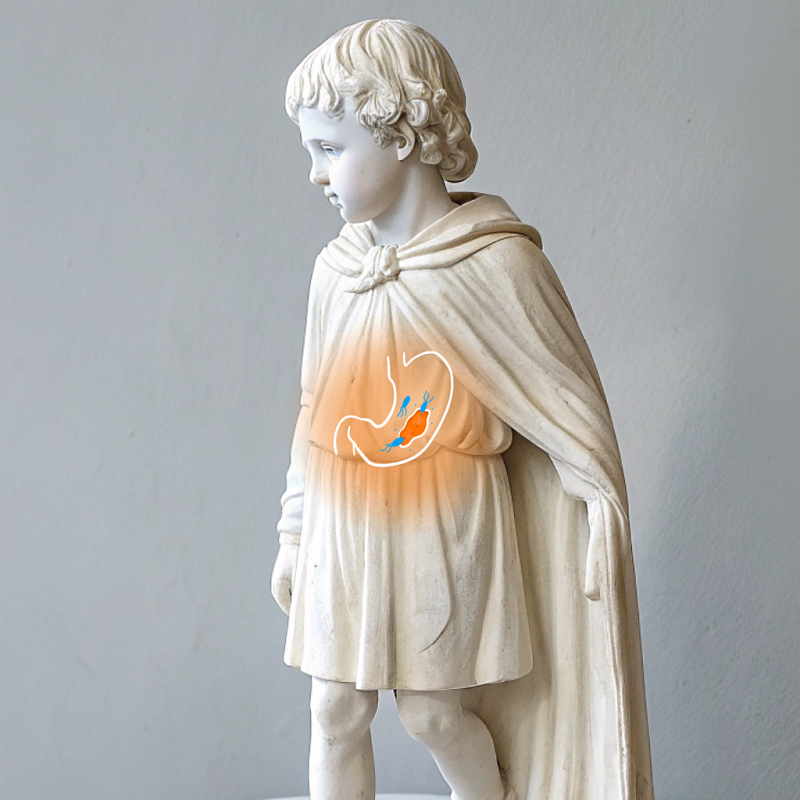Pediatric 13C-urea breath test
Pediatric 13C-urea breath test is a painless, non-invasive method used to detect Helicobacter pylori infection in children. It is based on the ability of H. pylori to break down urea using the enzyme urease

During the test, the child ingests urea containing labeled carbon (13C). If H. pylori is present in the stomach, the urea is hydrolyzed by the urease enzyme into carbon dioxide and ammonia. The 13C-labeled carbon dioxide is absorbed into the blood and then exhaled. Samples of the child’s exhaled air are collected and tested before and after taking the 13C-labeled urea to see if Helicobacter pylori is in the body.
Before the test, it is necessary to consult a pediatric GI specialist, who will determine the indications and explain how to properly prepare for the procedure.
The test is performed on an empty stomach: the last meal should be at least 6 hours before the procedure. The day before and on the day of the test, you should avoid physical and emotional stress. The test cannot be combined with esophagogastroduodenoscopy (EGD) if it is scheduled for the same day. It is important to stop taking a number of medications that may affect the accuracy of the results in advance: antibiotics and bismuth preparations – 4 weeks before, proton pump inhibitors – 2 weeks before, and antacids and H2 blockers – 1-2 days before the procedure. These restrictions must be observed under the supervision of the attending physician.
Before starting the test, children must brush their teeth and rinse their mouth thoroughly to eliminate food residues or bacteria. Then, a primary exhalation is performed: the patient exhales into a sealed bag marked with a blue label. After that, they take a capsule containing 13C-labeled urea and sit still for 30 minutes. After this, a second (diagnostic) breath is taken into a red-marked bag, which is also immediately sealed. Both bags (with the primary and diagnostic samples) are sent to the laboratory for analysis.
We use a 13C-labeled urea capsule, two sealed bags for collecting exhaled air (labeled blue and red), and plugs to seal them tightly. Additionally, we use lab equipment that can detect the concentration of carbon dioxide with the 13C isotope in exhaled samples.
There's no recovery period after the procedure: children can go back to their regular activities the same day.
Benefits
Fast
The procedure takes about 40 minutes.
Highly accurate
Provides reliable detection of Helicobacter pylori.
Outpatient
Requires no hospitalization and is performed in comfortable conditions
Painless
The procedure is performed without punctures, probes, which makes the child comfortable.
Врачи
Смотреть всех врачейIndications and contraindications
Indications
– Monitoring the effectiveness of H. pylori eradication therapy
– H. pylori infection diagnosis
How to reach
How to get
From the Belorusskaya metro station of the Zamoskvoretskaya line - exit 4 After exiting the subway, walk through the pedestrian tunnel and climb the stairs. Move towards the railway tracks, go down the stairs immediately after them and walk along the house, then turn right onto 1st Yamskoye Pole Street. At the turn to 3rd Yamsky Pole Street, cross the road at the pedestrian crossing and continue along 1st Yamsky Field Street, after a few buildings on the left you will see Olympus Clinic MARS.
Travel time
9 minutes
Landmark
Olympus Clinic MARS sign
How to get
From the Belorusskaya metro station of the Ring line - exit 2. After exiting the subway, turn left and walk to the pedestrian crossing. Cross the road through two pedestrian crossings and move along the Tverskoy overpass. Go down the stairs immediately after the railway tracks, walk along the house, then turn right onto 1st Yamskoye Pole Street. At the turn to 3rd Yamsky Pole Street, cross the road at the pedestrian crossing and continue along 1st Yamsky Field Street, after a few buildings on the left you will see Olympus Clinic MARS
Travel time
11 minutes
Landmark
Olympus Clinic MARS sign


